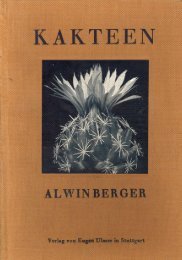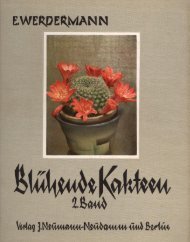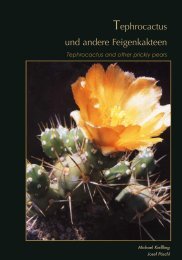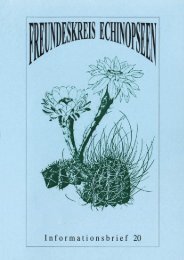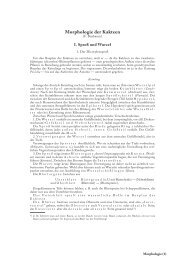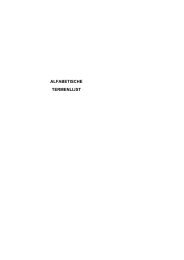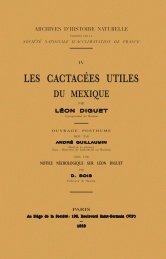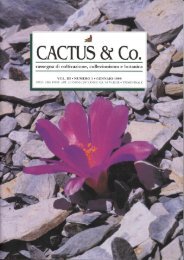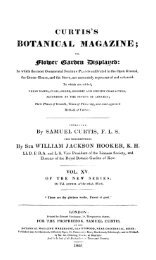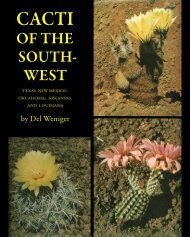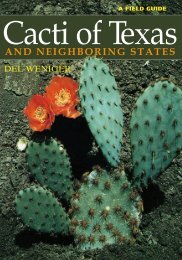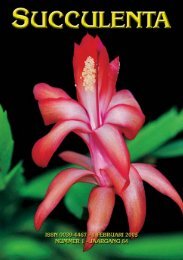H. WINTER - Bibliothèque numérique d'ouvrages sur les cactus et ...
H. WINTER - Bibliothèque numérique d'ouvrages sur les cactus et ...
H. WINTER - Bibliothèque numérique d'ouvrages sur les cactus et ...
Sie wollen auch ein ePaper? Erhöhen Sie die Reichweite Ihrer Titel.
YUMPU macht aus Druck-PDFs automatisch weboptimierte ePaper, die Google liebt.
Preise in DM<br />
47 FR 68 strausii var. Fricii Doerfl. Lange, weiße<br />
Wollhaare aus Scheitelnahen A. — Long<br />
woolly hairs out of around the top. — Longs<br />
poils blancs laineux des aréo<strong>les</strong> voisines du<br />
somm<strong>et</strong>. —,80 2,50 —<br />
48 FR 69 tarijensis Cardenas. Lange, gelbe, nach<br />
unten gericht<strong>et</strong>e St. Bl. rot. — Lg. yellow sp.<br />
tending downwards. This sp. will be named<br />
y<strong>et</strong>.— —,50 1,50 12,—<br />
49 FR 67 tupizensis. St. gelblich, rötlich. — Sp.<br />
yellowish, reddish. — Aig. jaunâtre-rougeâtre.<br />
—,40 1,50 12,—<br />
6 CLEISTOCACTUS spec. nov. aus Bolivien<br />
(Discussion Prof. Cardenas-Ritter)<br />
50 FR 106 spec. nov. St. zart und dicht: Bl. rot.<br />
— Sp. yellow-brown, many ribbed. — Aig. jaune-brun,<br />
côtes nombreuses. —,50 2,— —<br />
51 FR 112 de Tirata. St. stärker, gelb-braun.<br />
— Sp. strong, yellow-brown, prefers warm<br />
position. —,50 2,— —<br />
52 FR 108 spec. nov. Goldgelbe, zarte, St. —<br />
Interesting new Cl. which often forms large<br />
yellow tufts of brist<strong>les</strong>. Prefers a warm position.<br />
—,50 1,20 10,—<br />
53 FR 113 spec. nov. Groß, gelbstachelig. — Big,<br />
yellow sp. Comes from a cool climate. — Tige<br />
forte. Climat froid. —,50 2,— —<br />
54 FR 324 de Palhuaya. Beim Aufstieg in die<br />
Palhuaya-Schlucht fand ich meinen 3. Cleist.<br />
des Consata-Beckens. Weiß-hellgelbe St. Zitronengelbe<br />
Bl. — When climbing up in the<br />
Palhuay gorge, I found my third Cleist. of the<br />
Consata basin, a very beautiful one, wrapped<br />
in white yellow light sp. — Aig. blanc-jaune<br />
clair, fl. jaune-citron. —,50 2,— —<br />
55 FR 325 spec. nov. An Felswänden besonders<br />
schöner Cleist. Triebe in haarförmige, dünne,<br />
helle St. gehüllt. Liebt Wärme.<br />
—,60 2,50 —<br />
CLISTANTHOCEREUS<br />
56 FR 149 hertlingianus (Bckbg.) see page 4<br />
CORRYOCACTUS (Büsche mit vielen Trieben)<br />
(Bitte die Namen dieser Gruppe im vorjährigen Katalog<br />
zu berichtigen)<br />
57 FR 122 brevistylus. St. 5—10 cm lang.<br />
—,40 1,50— 12,—<br />
58 FR 122a brevistylus var. Dicke Säulen. Riesige,<br />
rote St. — Strong stems, sp. red, gigantic,<br />
som<strong>et</strong>imes 45 cm long. — Aig. très lg., rouge<br />
vif. Espèce assez résistant an froid.<br />
—,40 1,50 12,—<br />
59 FR 176 brevistylus var. Säulen ca. 8 cm ∅,<br />
viel dünner als FR 122. — Many stems, more<br />
slender (8 cm ∅) than 122a.<br />
—,40 1,50 12,—<br />
60 FR 271 brachyp<strong>et</strong>alus. Vielästige Büsche,<br />
hellgrün-gelblich. — Big groupes, light green/<br />
yellowish. —,40 1,50 12,—<br />
61 FR 103 melanotrichus (90%). Rotblühender,<br />
* Säulencereus, Bolivien, 2000—4000 m. —<br />
Red fl. good germinative faculty. — Pl. très<br />
buissonante. —,40 1,50 12,—<br />
DENMOZA erythrocephala<br />
63 FR 10a Jungpflanzen meist rotstachelig. Im<br />
* Alter weißes Haar. — Young plants mostly<br />
black sp. White hair. — Jeunes plantes presque<br />
toujours aig. noirs. Poils blancs.<br />
—,50 1,— 8,—<br />
DIPLOPERIANTHIUM Ritter gen. nov., Peru.<br />
Wuchs wie Dendrocereus (Cuba), aber ganz<br />
absonderliche Blüten: Auf einheitlichem Fruchtknoten<br />
u. Nektarkammer 2 Blütenhüllen, eine<br />
äußere, außen mit bestachelten Areolen, innen<br />
beschuppt, ohne Blütenblätter, — in ihr eine<br />
nackte innere mit Schuppen und Blütenblättern.<br />
— Gen. nov.; new Peruvian genus, in<br />
habit like the Cuban Dendrocereus, but with<br />
most extraordinary flowers: On a unitary ovary<br />
and nectary 2 perianths, an outer one, with<br />
spinous areo<strong>les</strong> on the outside, scaly on the<br />
inside, without p<strong>et</strong>als. Within it a naked, inner<br />
one, with sca<strong>les</strong> and p<strong>et</strong>als. — Gen. nov. port<br />
semblable à Dendrocereus (Cuba), mais complètement<br />
différent par <strong>les</strong> fleurs, 2 enveloppes<br />
flora<strong>les</strong> autour de l’ovaire <strong>et</strong> de la chambre<br />
nectarifère, l’externe munie d’aréo<strong>les</strong> épineuses<br />
à l’extérieur <strong>et</strong> d’écail<strong>les</strong> à l’intérieur, l’interne<br />
nue, munie d’écail<strong>les</strong> <strong>et</strong> portant <strong>les</strong> segments<br />
du périanthe.<br />
63 a FR 315 substerile Ritter sp. nov. Einzige<br />
aussterbende Art. Nur sehr wenig Samen. Liebt<br />
Wärme u. Feuchtigkeit, sehr wüchsig. — The<br />
only species; becoming extinct, due to the<br />
aridity hardly forms seed therefore very little<br />
seed available. Loves warmth and moisture,<br />
strong grower. — Esp. en voie de disparition<br />
par suite d’une modification du climat. Peu<br />
de graines, forte croissance exige chaleur <strong>et</strong><br />
humidité. 10 S. 1.—<br />
5



